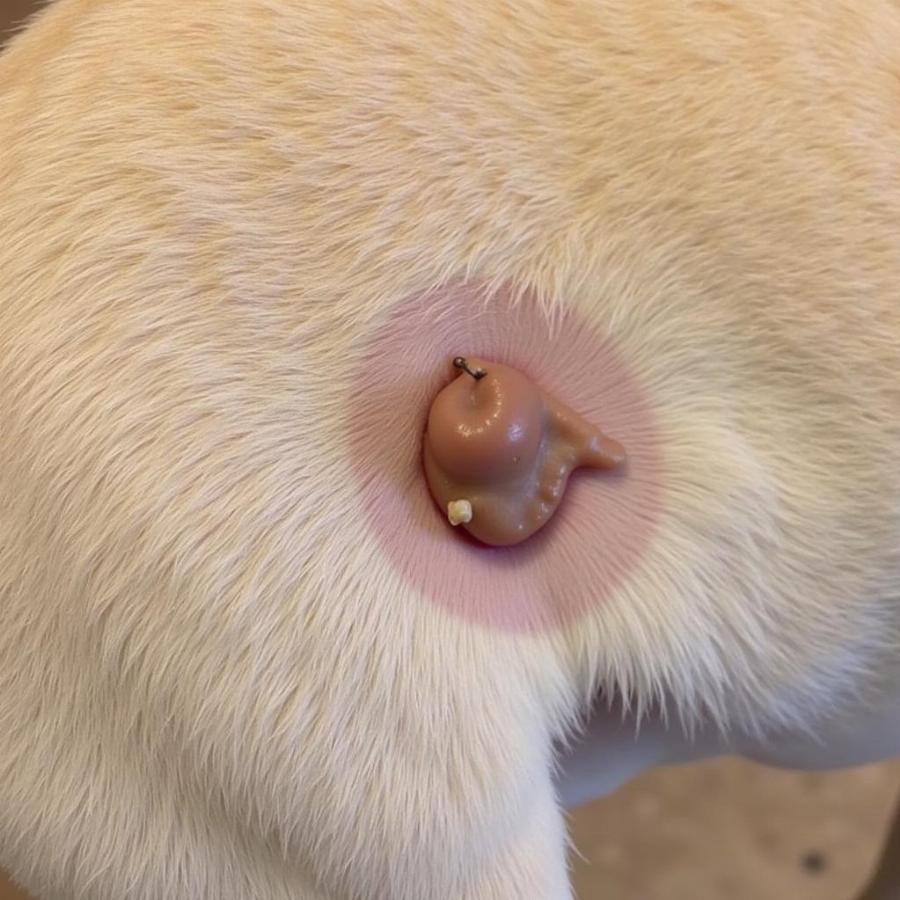Skin tags on dogs are a common occurrence, especially as they age. These small, fleshy growths are typically benign and don’t cause any discomfort. But how do you know for sure if it’s just a skin tag and not something more serious? This article will delve into everything you need to know about skin tags on dogs, from identification and causes to when it’s time to seek veterinary attention.
What Do Skin Tags on Dogs Look Like?
Skin tags, also known as acrochordons, usually appear as small, soft, fleshy protrusions from the skin. They can vary in color, from pink to brown or even black, and are often attached to the skin by a thin stalk or peduncle. They can appear anywhere on a dog’s body, but are often found in areas with folds, such as the armpits, groin, neck, and face. They can be single or multiple, and they may range in size from tiny bumps to larger, more noticeable growths.
 Dog Skin Tag Appearance
Dog Skin Tag Appearance
What Causes Skin Tags on Dogs?
While the exact cause of skin tags isn’t fully understood, several factors are thought to contribute to their development. Friction, genetics, and hormonal changes are often cited as potential causes. Older dogs, overweight dogs, and certain breeds like Cocker Spaniels, Beagles, and Boxers are more predisposed to developing skin tags.
Are Skin Tags Painful for Dogs?
Generally, skin tags are not painful for dogs. However, if a skin tag becomes irritated due to rubbing against clothing or collars, or if it gets caught or twisted, it can become inflamed and painful. A hunting dog collar, specifically, might cause irritation if it rubs against a skin tag in the neck area. Therefore, it’s important to monitor any changes in the appearance or your dog’s behavior related to the skin tag.
When Should I Worry About a Skin Tag on My Dog?
While most skin tags are harmless, it’s crucial to differentiate them from other skin growths that may be cancerous. Any new lump or bump, or any change in an existing skin tag, warrants a veterinary examination. Look out for rapid growth, bleeding, discoloration, inflammation, or if the dog appears to be bothered by it.
How Are Skin Tags on Dogs Diagnosed?
A veterinarian will typically diagnose a skin tag through a physical examination. In some cases, they may recommend a fine-needle aspiration or biopsy to confirm the diagnosis and rule out other conditions, especially if there’s any concern about malignancy.
How Are Skin Tags on Dogs Treated?
If a skin tag isn’t bothering the dog, treatment is often unnecessary. However, if the tag is causing irritation, bleeding, or is located in a problematic area, surgical removal is a straightforward procedure. Cryosurgery (freezing) or electrocautery (burning) can also be used to remove small skin tags. Check out our article on what causes skin tags on dogs for more in-depth information.
Can I Remove a Skin Tag on My Dog at Home?
Never attempt to remove a skin tag on your dog at home. Doing so can cause bleeding, infection, and unnecessary pain for your dog. Always consult a veterinarian for proper diagnosis and treatment.
Can Skin Tags on Dogs Come Back?
While surgically removed skin tags are unlikely to recur in the same location, new skin tags can develop in other areas of the body. This is especially true in breeds predisposed to skin tags. You can personalize your dog’s identification with a custom army dog tags.
Preventing Skin Tags on Dogs
While completely preventing skin tags might not be possible, maintaining a healthy weight for your dog and using a well-fitting collar can minimize friction and potentially reduce the likelihood of skin tags developing, particularly in the neck area. Alternatively, consider a necklace dog tag.
Conclusion
Skin tags on dogs are generally benign, but it’s always best to err on the side of caution. Regularly checking your dog’s skin and seeking veterinary advice for any new or changing growths will ensure your furry friend stays healthy and comfortable. Knowing the difference between a harmless skin tag and a potentially more serious condition gives you the power to make informed decisions about your dog’s health. Remember, early detection is key.
FAQ
-
Are skin tags contagious? No, skin tags are not contagious.
-
Are skin tags a sign of old age in dogs? While more common in older dogs, they can occur in dogs of any age.
-
Can diet affect the development of skin tags? A healthy diet contributes to overall skin health, but there’s no direct link between diet and skin tag development.
-
Do all dog breeds get skin tags? Some breeds are more prone to skin tags than others.
-
Will my dog need anesthesia for skin tag removal? It depends on the size and location of the skin tag. Your veterinarian will determine the best course of action.
-
How long does it take for a surgically removed skin tag to heal? Healing time is usually about 7-10 days.
-
Can I prevent skin tags by grooming my dog regularly? Regular grooming can help you detect skin tags early but doesn’t prevent their development.
Other Questions You Might Have
- Are there home remedies for skin tags on dogs?
- How much does it cost to remove a skin tag on a dog?
- What other types of skin growths can dogs develop?
Check out our articles on motorcycles and dogs to learn about traveling safely with your canine companion.
Beaut Dogs is your go-to source for reliable and insightful information about the world of dogs. We offer expert advice on everything from breed selection to health and wellness. When you need expert advice, contact us at [email protected] for detailed and accurate information. Beaut Dogs is committed to providing you with the knowledge you need to care for your beloved canine companion. Visit us at https://beautdogs.com to explore the wonderful world of dogs!